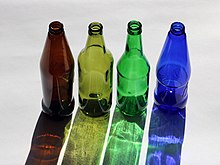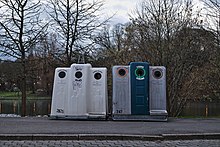This article may be unbalanced toward certain viewpoints. (March 2024) |



Glass recycling is the processing of waste glass into usable products.[1] Glass that is crushed or imploded and ready to be remelted is called cullet.[2] There are two types of cullet: internal and external. Internal cullet is composed of defective products detected and rejected by a quality control process during the industrial process of glass manufacturing, transition phases of product changes (such as thickness and color changes) and production offcuts. External cullet is waste glass that has been collected or reprocessed with the purpose of recycling. External cullet (which can be pre- or post-consumer) is classified as waste. The word "cullet", when used in the context of end-of-waste, will always refer to external cullet.
To be recycled, glass waste needs to be purified and cleaned of contamination. Then, depending on the end use and local processing capabilities, it might also have to be separated into different sizes and colours. Many recyclers collect different colors of glass separately since glass tends to retain its color after recycling. The most common colours used for consumer containers are clear (flint) glass, green glass, and brown (amber) glass. Glass is ideal for recycling since none of the material is degraded by normal use.
Many collection points have separate bins for clear (flint), green and brown (amber). Glass re-processors intending to make new glass containers require separation by color. If the recycled glass is not going to be made into more glass, or if the glass re-processor uses newer optical sorting equipment, separation by color at the collection point may not be required. Heat-resistant glass, such as Pyrex or borosilicate glass, must not be part of the glass recycling stream, because even a small piece of such material will alter the viscosity of the fluid in the furnace at remelt. [3]
- ^ Dyer, Thomas D. (2014). "Glass Recycling". Handbook of Recycling: 191–209. doi:10.1016/B978-0-12-396459-5.00014-3. ISBN 978-0-12-396459-5.
- ^ "Glass, Common Wastes & Materials". US EPA. Retrieved 22 April 2012.
- ^ "First in glass: 10 homegoods for Recycle Glass Month". MNN – Mother Nature Network.